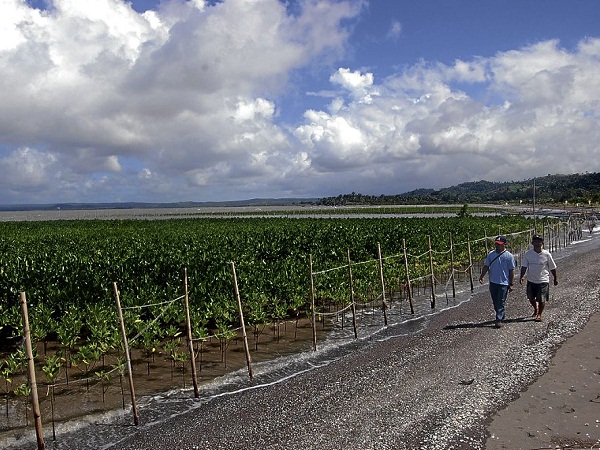
THIS MANGROVE plantation in Barangay Cagsao, Calabanga, Camarines Sur, has been attacked by pests. JUAN ESCANDOR JR./INQUIRER SOUTHERN LUZON
CALABANGA, Camarines Sur—Pests have descended upon more than 5 hectares of mangrove plantation in Barangay Cagsao in this town, affecting about 80 percent of the trees.
Gilbert C. Gonzalez, acting regional director of the Department of Environment and Natural Resources (DENR) in Bicol, said the technical team of the DENR was sent to the mangrove plantation here to validate the concern raised by Mayor Evelyn Yu of pests attacking the leaves of mangrove trees planted on the once barren shores of Cagsao.
The affected mangrove trees were mostly planted only three years ago, spreading across the tidal flats and providing the community a barrier against storm surges.
The mangrove plantation was initiated by the community in partnership with the local government, line agencies, nongovernment organization, private entities and individual volunteers in line with disaster risk management program.
Feliciano Lauricio Jr., DENR’s surveillance officer, said the mangrove plantation was being attacked by Tussock moth (Lipedoptera Lymatriidae) whose larvae (caterpillars) gobble the leaves of mangrove trees and make the weak ones wilt.
Lauricio, however, assured the public that moves had been taken to eradicate the pest, using a spray made of liquid laundry soap mixed with chilli powder and by manually removing the pests’ larvae.
The more than 5 ha of mangrove plantation, a green canopy rising and creeping above the shallow tidal flat, was established in 2009.
Some 371 kilometers south of Manila and 39 km northeast of Naga City, the mangrove plantation is part of the disaster risk reduction and mitigation plan of the community, according to village chief Pascual Sta. Ana.
Cagsao, a coastal village highly vulnerable to storm surges, nestles on the side of a steep hill that drops to a narrow shore line, is the home of 1,629 people, mostly depending on fishing for their livelihood. There are 582 households with 730 families clustered in seven zones.
Sta. Ana said the mangrove plantation was one of the small-scale mitigation measures that the community embarked on to build a natural buffer against storm surges.